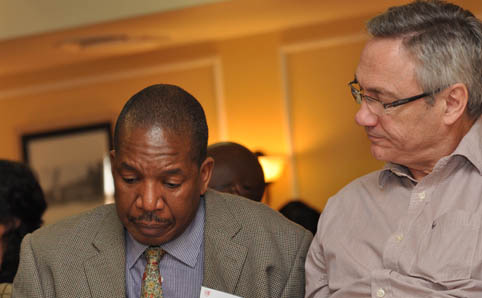 |
Proff. Charles Ngwena and Loot Pretorius, both from the Department of Constitutional Law and Philosophy of Law at the UFS.
Photo: Stephen Collett |
Our Department of Constitutional Law and Philosophy of Law of the Faculty of Law recently convened a two-day colloquium with the theme, ‘Strengthening protection of reproductive and sexual health in Africa through human rights’.
The colloquium built upon the work of the university’s LLM Programme in Reproductive and Sexual Rights, which trains law graduates to become specialists in reproductive and sexual health as human rights. The LLM Programme was first established in 2005. The colloquium brought together delegates from different professional backgrounds, including academia, health sciences and human-rights advocates from across the African region as well as from abroad.
Delegates addressed the theme of the colloquium in sessions organised around the topics: HIV/Aids and human rights; sexual health and sexual rights; reproductive health and rights; abortion-related issues; and the intersection between cultural and religious perspectives and sexual and reproductive health and rights.
According to Prof. Charles Ngwena, Director of the LLM Programme, and co-convener of the colloquium together with Dr Ebenezer Durojaye, Postdoctoral Fellow in the Department of Constitutional Law at the UFS, the discussions flowing from the papers were to:
- identify a persistent gap or challenge in the respect, protection and realisation of reproductive and/or sexual health as a human right under African human rights systems; and
- advance arguments and suggestions that are aimed at addressing the gap or challenge and ultimately strengthening African human rights systems.
To address the regional dimension of the colloquium, the papers delivered ultimately addressed selected reproductive and/or sexual health or right issues from a regional rather than a mere country perspective so that the experiences and challenges of the African region are captured.